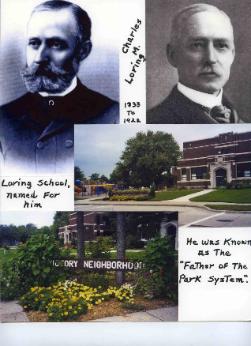Behind the Victory Flagpole — Charles M. Loring
Once upon a time there was a man who lived in Minneapolis who was referred to as the "Father of the Park System." His name was Charles M. Loring and he was born in Portland, Maine on November 13, 1833. His parents were Captain Horace and Sarah (Wiley) Loring, with Captain Horace being a famous shipmaster who traded in the West Indies. His parents desired that their son should take over the business, thus they took him on many long voyages when he was in his teens. He advanced to the position of mate, then in 1854 was put in command of a ship that cruised into a Cuban port, where he directed trading.
This career did not last long, as the call of the west lured him away from the sea, and in 1856 he headed to Chicago. There he became a business man, first as a wholesale merchant, then as a grain trade magnate. Spending four years in the "city by the lake," he then disposed of his business interests and moved to Minneapolis.
Here are some of the businesses he was involved in: Manager of a supply store of Dorilus Morrison; general merchandiser under the firm of L. Fletcher & Co.; one of the buyers of Holly mill, along with Mr. Fletcher and W.E Cahill; buyer of the Galaxy mill; buyer and supervisor of Minnetonka mill until 1880, when he turned the business over to his son, A.C. Loring; and he became head of North American Telegraph Co. in 1885 and continued as chief executive until 1897.
One thing about Loring was that he was very generous! Whereas many men would have hoarded their worldly goods for their own gain, he shared his fortune and contributed greatly to many different organizations for the betterment of the city. He acted as president of the Mpls. Board of Trade in 1875, and was president of the Chamber of Commerce from 1886 until 1890.
After having lived in Minneapolis for only four years, he was elected to his first political position-that of road supervisor-and in 1872 was elected a member of the city council from the 5th ward. From the beginning he seemed to recognize the potential of this great and growing western city, and believed that its beauty spots should be preserved for future generations. He cooperated with every agency which was planning to promote beauty in the city and in 1872 was appointed by the State Horticultural Society to draft the constitution and by-laws of that society. In 1880 he became president of the State Forestry Assoc. and also president of the Lakewood Cemetery Assoc. In 1883 the park commission was organized; and being its first president he devoted most of his public service to the development of parks, planting of trees and beautification of the city.
On April 11, 1919 he placed with a trust company $50,000, which was called the Loring Tree Trust. The income from this was to be paid to the board of park commissioners for the perpetual care of the trees on Victory Memorial Drive. As you know, the 568 trees were planted in honor of the soldiers from Hennepin County who gave their lives for the country in WWI, and the dedication was in June of 1921.
Loring had been married twice, first to Emily Crosman, who passed away and left an only son, A.C. Loring. Then to Florence Barton, who was active in charitable and civic work along with her husband.
Charles M. Loring passed away March 18, 1922 at age 88. His last public act was in connection with the Victory Memorial Drive. A member of the park board said, "I feel that Mr. Loring has done more toward beautifying Minneapolis than any other individual." Another said, "Minneapolis owes a debt of gratitude to Mr. Loring. He made the creation of a park board possible. No single man in Minneapolis has done more for its welfare than he."
So, after living in the city for nearly six decades, being an early merchant, pioneer flour miller, father of the park system and promoter of beautifying Minneapolis, the city gratefully acknowledged its indebtedness to Charles M. Loring. They named a school after him. They named a park near downtown Minneapolis after him. The first Loring School was built totally out of wood in 1924. The current brick one was constructed in 1928.

Note: Excerpts taken from Minnesota and Its People by J.A. Burnquist. School photography by Jeanne Meyer Edberg.